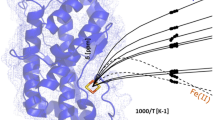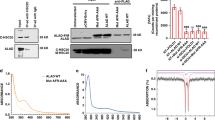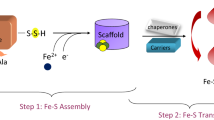Abstract.
Ferrochelatase (E.C. 4.99.1.1, protoheme ferrolyase) catalyzes the insertion of ferrous iron into protoporphyrin IX to form protoheme (heme). In the past 2 years, the crystal structures of ferrochelatases from the bacterium Bacillus subtilis and human have been determined. These structures along with years of biophysical and kinetic studies have led to a better understanding of the catalytic mechanism of ferrochelatase. At present, the complete DNA sequences of 45 ferrochelatases from procaryotes and eucaryotes are available. These sequences along with direct protein studies reveal that ferrochelatases, while related, vary significantly in amino acid sequence, molecular size, subunit composition, solubility, and the presence or absence of nitric-oxide-sensitive [2Fe-2S] cluster.
Similar content being viewed by others
Author information
Authors and Affiliations
Additional information
Received 17 May 2000; revised 28 June 2000; accepted 30 June 2000
Rights and permissions
About this article
Cite this article
Dailey*, H., Dailey, T., Wu**, CK. et al. Ferrochelatase at the millennium: structures, mechanisms and [2Fe-2S] clusters . CMLS, Cell. Mol. Life Sci. 57, 1909–1926 (2000). https://doi.org/10.1007/PL00000672
Issue Date:
DOI: https://doi.org/10.1007/PL00000672




